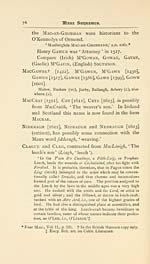Download files
Complete book:
Individual page:
Thumbnail gallery: Grid view | List view

Suttnamea bcrttrctJ ftrmtt Crafts, rfr. 77
On a stone at the Friary, Arbory, Professor Rh^s has
recently discovered the name Mac Leog, in the Ogam
character. This late form would seem to show that Ogam
writing lingered in the Isle of Man till the ninth century.
' MacLiag, Chief Poet of Erinn,' A.D. 1014.*
' Gilla MacLiag (Gelasius), the son of Rory, the successor
of St. Patrick, and Primate of Armagh and of all Ireland
.... died A.D. ii73.'t
In 1405, Gilbert Cleg received letters of protec-
tion from Henry IV. to come to the Isle of Man.:]:
It is possible, but not probable, that the forms
Cleg and Clegg may be derived from (O.N.)
kleggi, ' a horse-fly.' The word Cleg is used in the
Isle of Man, as well as in Scotland and the north
of England, to designate this insect. Clague is
now the commonest form, but did not become so
till early in the eighteenth centur3^
Cleg [1405], MacClewage, MacCluag [1511], Clev-
age [1521], Cloagge, Cloage [1601], Claige
[1622], Clogue [1625], Cleage [1644], Clauge
[1652], Clague [1655], Cloauge [1660], Cluage
[1673], Cloiage [1674], Cluag [1676], Claig [i6g6],
Claigue [1702], Cloag [1719], Clage [1775],
Clegg [1790].
Marown, Santon (vc), Malew, Michael, Jurby, Lezayre,
Ballaiigh, Braddan, Lonan, Maughold, Rushen (c), else-
where (u).
Kerd and Mac Kerb [15 ii] (obsolete), from Ccard, ' an
artificer, artist-mechanic'
KiNViG and Kinred seem to have been originally nick-
names, which became surnames at a comparatively
recent date. The prefix kin is the genitive of kione
' head,' which would preclude their being simply
* Chron. Scot., p. 257. f Four Mast., Vol. III., p. 13.
X Manx Society, Vol. VII., p. 231.
On a stone at the Friary, Arbory, Professor Rh^s has
recently discovered the name Mac Leog, in the Ogam
character. This late form would seem to show that Ogam
writing lingered in the Isle of Man till the ninth century.
' MacLiag, Chief Poet of Erinn,' A.D. 1014.*
' Gilla MacLiag (Gelasius), the son of Rory, the successor
of St. Patrick, and Primate of Armagh and of all Ireland
.... died A.D. ii73.'t
In 1405, Gilbert Cleg received letters of protec-
tion from Henry IV. to come to the Isle of Man.:]:
It is possible, but not probable, that the forms
Cleg and Clegg may be derived from (O.N.)
kleggi, ' a horse-fly.' The word Cleg is used in the
Isle of Man, as well as in Scotland and the north
of England, to designate this insect. Clague is
now the commonest form, but did not become so
till early in the eighteenth centur3^
Cleg [1405], MacClewage, MacCluag [1511], Clev-
age [1521], Cloagge, Cloage [1601], Claige
[1622], Clogue [1625], Cleage [1644], Clauge
[1652], Clague [1655], Cloauge [1660], Cluage
[1673], Cloiage [1674], Cluag [1676], Claig [i6g6],
Claigue [1702], Cloag [1719], Clage [1775],
Clegg [1790].
Marown, Santon (vc), Malew, Michael, Jurby, Lezayre,
Ballaiigh, Braddan, Lonan, Maughold, Rushen (c), else-
where (u).
Kerd and Mac Kerb [15 ii] (obsolete), from Ccard, ' an
artificer, artist-mechanic'
KiNViG and Kinred seem to have been originally nick-
names, which became surnames at a comparatively
recent date. The prefix kin is the genitive of kione
' head,' which would preclude their being simply
* Chron. Scot., p. 257. f Four Mast., Vol. III., p. 13.
X Manx Society, Vol. VII., p. 231.
Set display mode to: Large image | Transcription
Images and transcriptions on this page, including medium image downloads, may be used under the Creative Commons Attribution 4.0 International Licence unless otherwise stated. ![]()
| Early Gaelic Book Collections > Blair Collection > Surnames & place-names of the Isle of Man > (95) |
|---|
| Permanent URL | https://digital.nls.uk/82100788 |
|---|
| Description | A selection of books from a collection of more than 500 titles, mostly on religious and literary topics. Also includes some material dealing with other Celtic languages and societies. Collection created towards the end of the 19th century by Lady Evelyn Stewart Murray. |
|---|
| Description | Selected items from five 'Special and Named Printed Collections'. Includes books in Gaelic and other Celtic languages, works about the Gaels, their languages, literature, culture and history. |
|---|

